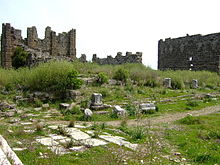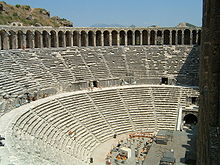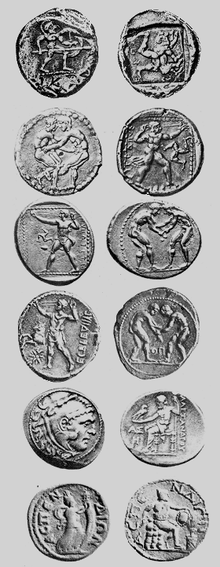Aspendos
Coordinates: 36 ° 56 ' N , 31 ° 10' E
Aspendos ( Greek Ἄσπενδος ) was an ancient city in Pamphylia in Asia Minor on the south coast of what is now Turkey , near the village of Büyükbelkiz , about 5 km east of Serik . The great theater from Roman times is one of the best preserved in antiquity . It is still used for performances today. The city of Aspendos has not been excavated. All of the towering buildings date from the Roman heyday of the 2nd and 3rd centuries AD, when Aspendos was a major Pamphylian trading center. The location is 46 kilometers east of Antalya on the road to Alanya .
history
According to Greek tradition, Aspendos is said to be around the 12th century BC. Was founded by settlers from the Peloponnesian Argos . The legendary seer Mopsos , who was also venerated as the city father by cities like Perge , was considered one of the founders.
The coins of Aspendos from the 5th to 3rd centuries BC BC show the name Estwediiys (Greek ΕΣΤFΕΔIIΥΣ), which probably refers to an originally Hittite foundation, as it can be assumed that it was the local, Pamphylian name of the place. The letter F is the Digamma (δίγαμμα), which was originally the sixth letter of the Greek alphabet and had the sound value [w]. The digamma was lost early in the Attic-Ionian dialect and is no longer present under the Greek letters as they are taught in schools.
The city had a very eventful history and was under Lydian , Persian , Greek , Ptolemaic , Seleucid , Roman , Byzantine and Seljuk rule for 800 years . During the Byzantine period the city was called Primoupolis for a while. Little is known from its Greek history - excavations can certainly bring more knowledge about the pre-Roman era in the future.
The battle at Eurymedon is documented in literature . As a port city, Aspendos was previously connected to the sea by the river Eurymedon (today Köprü Çayı ) and thus achieved lasting prosperity. In the last battle of the Persian Wars , the Athenian general and fleet leader Kimon defeated there in 466 BC. Chr. The Persians in a double battle on land and water. Since then, the Eurymedon has politically marked the separation of the spheres between the eastern Persian area of influence and Greek Asia Minor in the west. Under Alexander the Great , Aspendus had to pay tribute after initial resistance. In Roman times, the city was able to develop a predominantly good relationship with Rome and reached its greatest boom as an important trading center in the region. In particular, the export of wine, oil, salt and horses brought Aspendos wealth and prosperity. Aspendos was the seat of a bishop; The titular bishopric of Aspendos of the Roman Catholic Church goes back to the diocese.
theatre
The Aspendos Theater is part of the ancient city of Aspendos. It is very well preserved and is still used today for opera and ballet festivals. Luciano Pavarotti and José Carreras performed among others . Also in 2005 an open-air broadcast of Wetten, dass ..? instead of.
As an alternative to this, the “Gloria Aspendos Arena” has been built near the ancient theater in Aspendos, because the ancient theater is no longer available for such performances for security reasons. Experts and the local museum management were no longer responsible for the damage that the ancient theater took to the structure of the building in the past due to the vibrations of loud music, so it was decided to take this step.
The theater is a Roman building, the full height of the stage has been preserved. The inside of the earlier eight-meter-wide wooden stage was decorated with rich column decorations, beams, friezes, rosettes and ornaments, of which today's remains give a good impression. The central gable in the middle of the wall has been preserved and shows a relief of Dionysus . Underneath the top of the wall, the recesses can still be seen, on which a sloping wooden construction rested, which spanned the stage and ensured even better acoustics.
On the outside of the stage there is an inside script written in Greek and Latin. She mentions the construction period of Marc Aurel (161–180) as the imperial period , Zenon as the architect and the Curtius brothers as the founder of the theater. The cavea comprises 41 rows of seats, which are divided by an intermediate aisle ( diazoma ), and can accommodate up to 20,000 spectators. Since the Seljuks used the theater as a caravanserai in the Middle Ages , it was constantly repaired and restored after earthquakes . This explains the good state of preservation compared to the buildings in the area.
The theater is one of the public buildings in the lower city. Further south are the remains of the thermal baths and the sports facility, the gymnasium . To the northeast is the less well-preserved stadium . To the west of the theater is the Acropolis (German castle hill) with the upper town of Aspendos. It was secured with its own wall, a city gate is still preserved.
In addition to numerous cisterns , the water supply was ensured by an aqueduct that is still in good condition today , which leads from the northern plain to the city.
Remaining remains of the city
The still largely towering Roman building remains on the Acropolis Hill are grouped on three sides around a rectangular square. On the long sides to the west and east it is bordered by long market halls. The eastern building is 142 meters long, ends with an exedra at the south end and ends in the north with a mighty, 15-meter square building. The north side of the square is dominated by the two-storey facade of a nymphaion , which was probably fed by the aqueduct. Niches for sculptures and front cornice for columns and gables are evidence of the originally splendid furnishings. The building behind it on the northwest corner probably served as a bouleuterion (German council chamber). There is also a temple above the stadium on the Temple Mount; which deity he was dedicated to is still unclear. Since Athena and Zeus are depicted on coins from Aspendos (around 450 BC), the temple could have been dedicated to one of these deities.
The upper town is partly accessible with stony, but easily accessible trails (even in winter after heavy rainfall) and sufficient signs. The area, which was otherwise largely left to itself, has now been cleared of undergrowth and bushes.
Coins
The first silver coins show armed hoplites as a symbol for the military on one side, and triskeles on the other (row 1, 460–420 BC). The letters Ε, ΕΣ, ΕΣΤ, ΕΣΤFΕ, ΕΣΤFΕΔIIΥ appear. The latter means money in German from ΕΣΤFΕΔΥΣ . Later coins show two wrestlers on one side, a slinger and the well-known triskeles on the other (row 2–4, 400–250 BC). The goddess Athena, Heracles, Zeus and Alexander the Great are depicted even later (row 5, 200–150 BC). AΣ for AΣΠΕNΔOΣ also appears here for the first time. The coins from Roman times bear the symbols of the respective Caesar and the inscription AΣΠΕNΔION (row 6, 200–300 AD).
Other sights in the area
Nearby, the almost 260 meter long Eurymedon Bridge (Köprüpazar Köprüsü) crosses the river of the same name. The Seljuk pointed arch structure in its present form rests on Roman foundations.
Individual evidence
- ↑ Aspendos Festival - Current Program 2012 ( Memento from June 16, 2012 in the Internet Archive ), accessed on May 21, 2012
- ↑ a b Erica wishes: ADAC travel guide Turkey - south coast. ADAC-Verlag, Munich 2011, pages 117–118, ISBN 978-3-89905-516-0
- ^ Aspendos Festival - History of the Theater ( Memento from September 4, 2011 in the Internet Archive ), accessed on May 21, 2012
- ^ Klaus Grewe et al .: In a zigzag course over the river. The Roman / Seljuk Eurymedon Bridge of Aspendos (Turkey) , in: Ancient World , Volume 30, No. 1 (1999), pp. 1–12.
literature
- Theodor Kraus , Friedrich Rakob : Roman architecture . In: Propylaea Art History: The Roman Empire . Propylaea, Berlin 1990, ISBN 3-549-05113-1 .
- M. Eddip Özgür: Aspendos . Net Turistik Yayinlar As, Istanbul 1998, ISBN 975-479-024-8 .
Web links
- Description, pictures and plans of Aspendos in Pamphylia , accessed January 12, 2011
- Bernd Liermann: Pressure section and hydraulic towers in Aspendos , accessed on January 12, 2011
- Coins of Aspendos (English)









